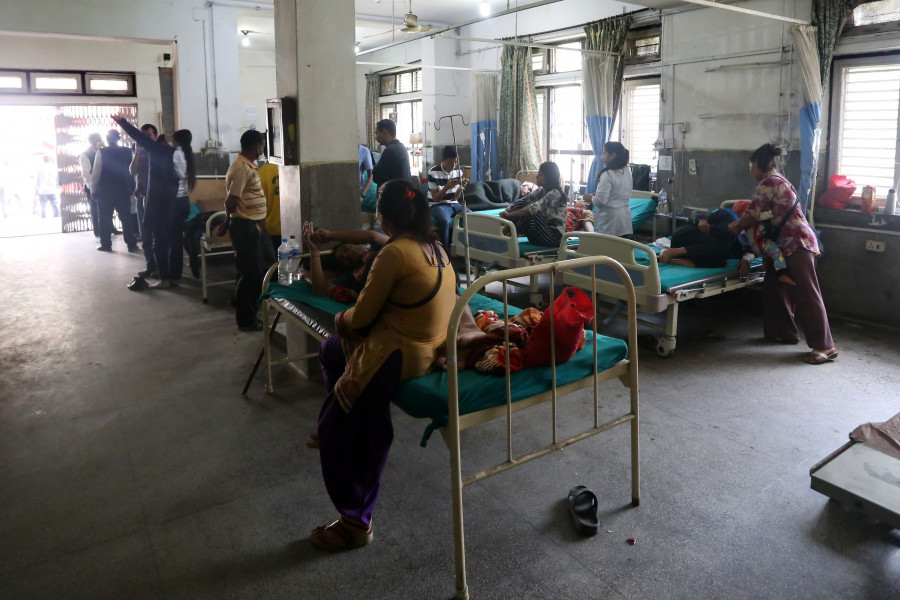Health
Dengue threat is not over yet even though it’s already winter, doctors say
Six South Asian Games players from Sri Lanka admitted to hospital for dengue virus; half a dozen dengue cases are reported in Kathmandu every day.
Arjun Poudel
Six Sri Lankan players, who are in Nepal to participate in the ongoing South Asian Games, have been hospitalised after contracting dengue, once again raising concerns that the disease-carrying mosquitoes are still active even after the onset of winter.
Of the players infected with dengue, Gayathri Nanayakkara has been admitted in the intensive care unit of Blue Cross Hospital near Dashrath Stadium in Tripureshwor.
The hospital administration said Nanayakkara was airlifted from Pokhara on Saturday.
"She is recovering well and she is out of danger," Rajat Shrestha, a board member of the hospital, told the Post. "Other five players have been receiving treatment in the general ward."
It, however, was not immediately clear whether the Sri Lankans contracted the disease in Nepal, or they carried the virus from their home country which also saw a sudden increase in dengue cases this year.
Dr Bibek Kumar Lal, director at the Epidemiology and Disease Control Division, said the players might have been infected with the virus in their own country, as it takes one week or more for the symptoms to appear after the infection.
"Sri Lanka itself has been severely affected by the dengue outbreaks," said Lal. "the entire South Asian region have been struggling to overcome the disease."
Lal, however, did not rule out the chances of infection in Nepal.
“At least half a dozen people on average are still visiting hospitals in the Kathmandu Valley for dengue treatment,” Lal told the Post.
Several districts across the country including Pokhara of Kaski district have been still reporting dengue cases.
Dengue is a mosquito-borne viral disease, which is transmitted by female Aedes aegypti and Aedes albopictus mosquitoes. Both Aedes aegypti and Aedes albopictus mosquitoes, breed in clean water and are active during the day. The same mosquitoes also transmit chikungunya, yellow fever and Zika virus, according to the World Health Organization. The UN's health agency said that about half of the world's population is now at risk.
Dengue has killed six people and infected over 16,000 people from 68 districts out of 77 since the beginning of this fiscal year [July 17].
"We have been worried about dengue threat throughout the year, largely due to climate change and several other factors," said Lal. "We need to take precautionary measures round the year."
Experts say dengue virus spreads during the post-monsoon season. But this year, the outbreak happened before the onset of monsoon in the Kathmandu Valley.
The division said it has developed dengue treatment guidelines and imparted master trainer training to health officials of all seven provinces to combat the disease. Those officials, who received master trainer training, would provide training to officials concerned in their respective provinces. The division has been also continuing awareness drives against the dengue virus.
Dr Praksah Shah, chief of Vector-Borne Disease Control Section at the division, said that dengue cases decline after temperatures come down.
“But that does not mean the dengue season is over and risk is minimised,” said Shah. "The virus-carrying mosquitoes can easily survive in room temperature of Kathmandu Valley and become active in the day time."
According to Shah, people from across the country should take precautionary measures to be safe from the deadly virus.
Dengue was first reported in Nepal in 2004. Since then, dengue outbreaks have occurred almost every year. But this year, dengue cases were reported in an unprecedented number, with the disease spreading to 68 districts.
Doctors say a lot more people might have been infected with the virus, as people with mild symptoms usually do not visit the hospital, and 70 to 90 percent of dengue cases are asymptomatic.




 5.4°C Kathmandu
5.4°C Kathmandu













%20(1).jpg&w=300&height=200)
